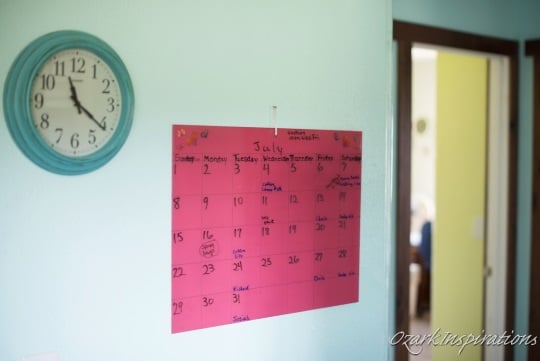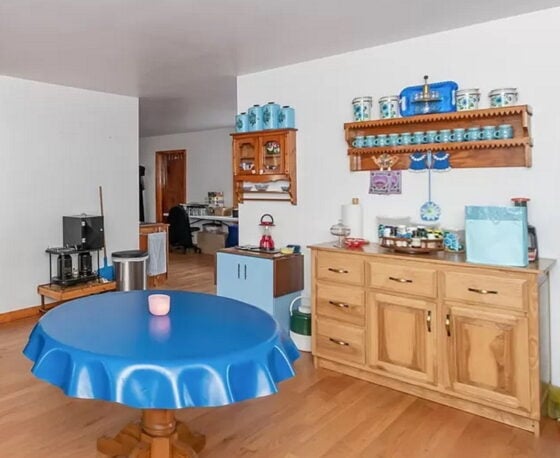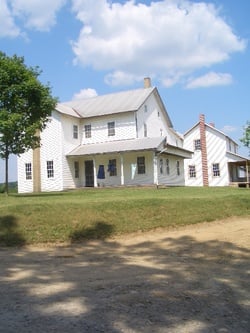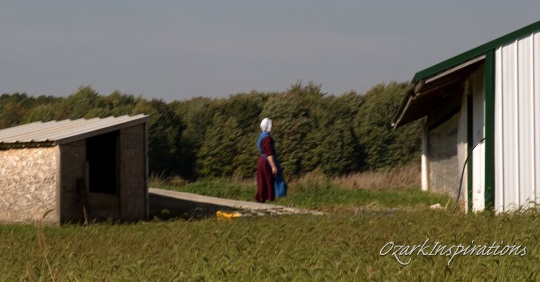Visiting the Amish at Burke’s Garden, Virginia (13 Photos)

We’ve had a number of looks at off-the-beaten path Amish communities lately, from the new settlement in northeastern Vermont to the Garnett, Kansas community to the Unity settlement in Maine.
 Today, reader Jerry takes us to another in that category–a community tucked away in an unusual valley in the southwestern end of Virginia.
Today, reader Jerry takes us to another in that category–a community tucked away in an unusual valley in the southwestern end of Virginia.
The following is Jerry’s account of his trip to the Burke’s Garden community, along with his photos of the area. You can tell he enjoyed his visit.
—
Getting there is a challenge. Steep decents coupled with many hairpin turns up and down the mountain keep you very aware that this is a special place. Burke’s Garden is a bowl-shaped valley scooped out of the rugged Appalachian Mountains in Southwest VA. It’s 3200 feet above sea level.
 There are two small natural gaps that drain the five mile-by-ten mile, 33,000-acre “Garden of Eden”. The valley was first discovered in the 1740s by James Burke. On his first visit someone discarded potato peelings near the camp site while making dinner (remember this). The next time Burke visited the area he found a bumper crop of potatoes growing there. Thus the name (jokingly) Burke’s Garden. It’s very remote.
There are two small natural gaps that drain the five mile-by-ten mile, 33,000-acre “Garden of Eden”. The valley was first discovered in the 1740s by James Burke. On his first visit someone discarded potato peelings near the camp site while making dinner (remember this). The next time Burke visited the area he found a bumper crop of potatoes growing there. Thus the name (jokingly) Burke’s Garden. It’s very remote.

Amish tried several years ago to settle the area but the locals would not sell them land. One generation later things have changed dramatically. Currently there are eight or nine families living there and they were received with open arms. Logic might suggest that they came from nearby Pearisburg but not so, the current Amish settling there are from western Kentucky. Lewisburg to be precise.

Once you land at the bottom of the mountain you will notice barns and garages with hex sign placards and horse-and-buggy road signs. At the next pull-off you will see an amazing panorama of the lower valley. A large dam, which captures all the soil erosion that happens naturally, is next. Go half-a-mile more and you will find the Burke’s Garden General Store.

It’s Amish-operated and is the meeting place for the whole valley. Bulk food, some groceries, snacks, fresh baked goods and the best sandwiches made to order await. Mattie runs the store and the locals love her and her wares. She makes pizza on Wednesday to die for. Everything is way too generous.

The buggy parked in front is like none other I’ve ever seen. Subtle differences but yet very different from what I’m used to. There is a fuel pump outside that I assume is for kerosene. There is seating inside next to a wood burning stove and the wraparound porch is inviting for al fresco dining. I can’t wait to eat a bowl of vegetable soup next to the stove in the cold weather. However, Mattie says her customer base would prefer a bowl of chili instead.

The first day I was there a quartet of locals were lunching on the porch. I went inside to interview the owner and our 30-minute conversation was nothing less than a cross-interview. We each asked questions of each other and both she and I learned so much. She refers to my Old Order Mennonite friends as “The Snyders” as they are from Snyder County, PA.
We vollied questions back and forth and the information could have filled several milk buckets. We talked about gardening and she told me that everything grows well in Burke’s Garden. She said that this year’s potato crop matured in just five weeks and there were no small fruit harvested. The new potatoes that she was looking for turned into jumbo bakers (flash back here to the 1740 explorers).

She planted “Yukon Golds” from “seed” she saved from last years crop. At this point she confirmed a long time rumor that the limestone rich loam top soil in the “garden” is no less than four feet deep. In Kentucky, top soil might have been 4 to 6 inches at best. They brought plows from Kentucky but they are not used. A cultivator for the top three inches is all that is required.
Church services are currently held in the eight families’ homes. A 56 x 24 barn was moved from Kentucky but not yet assembled. Hopefully, by this fall it will be erected. School is being held in the closed Burke’s Garden Elementary building that is now a community center.

The Amish rent one room, but the heating is not suitable and shortly a real Amish school building is planned.
The school is not funded by the typical Amish auctions since only eight families are there, but instead the Amish women hold fund raising suppers every Friday at the community center to raise funds. The locals love these and often there are more diners than food available. Auctions are planned in a few years.

Driving through the valley, I noticed several large farms are up for sale. Mattie told me that one 285-acre farm was just purchased by Lancaster Amish. She also said that a Holmes County group was visiting the valley this holiday weekend. I did notice a mobile camper with PA plates was in the area. They were indeed “camping” in the valley.

The locals are aging out and their children mostly are being educated at Virginia Tech and not interested in farming. Thus the many “for sale” signs. Agriculture is the valley is mostly summer grazing. Very few crops are raised.
The limestone soil is so rich and the grass so “sweet” that a steer can gain 3.5 pounds a day just by grazing. The beef cattle are sold every fall and new steers are brought in every spring for conditioning.
 As far as the nearby Pearisburg settlement, Mattie says that they are alive and well. One farmer on the lower part sold and moved on but three families still live on the “mountain”. I’m not sure what that means.
As far as the nearby Pearisburg settlement, Mattie says that they are alive and well. One farmer on the lower part sold and moved on but three families still live on the “mountain”. I’m not sure what that means.
A big thanks go out to Jerry for the virtual visit to Burke’s Garden, which sounds like a lovely place. I had heard it was an interesting area, but now I understand why.
The valley actually resembles a crater from above, as you can see in this aerial photo.

There are different stories as to the valley’s origin, but apparently the most commonly-accepted one holds that a limestone mountain collapsed upon itself following erosion of its sandstone cap.
A footnote: as Jerry hinted at above, a previous Amish settlement once existed at Burke’s Garden, for about a decade, from 1990 to 1999 (see David Luthy’s Why Some Amish Communities Fail: Extinct Settlements, 1961-2007). The current community has been in place since 2012.
Image credit: Burke’s Garden aerial view- zeesstof/flickr







This group is not old order is it? I wonder how it compares to the white gate community in terms of use of technology.
Anne in other words are you wondering if this is a New Order community?
The “Old Order” term is a little confusing b/c in its basic meaning it covers all horse and buggy groups, so yes it would be an Old Order/horse-and-buggy Amish group.
But when you talk about affiliations, say those in Holmes County, the term can also refer to a specific affiliation (rather than say New Order or Swartzentruber). Maybe Jerry can answer the question for us.
Great post! Thanks! It definitely would be a great place to explore.
Burke's Garden, VA
Does this valley have a nickname like some of the valleys do in Pennsylvania (Big Valley, Sugar Valley, Buffalo Valley, Nittany Valley)?
On photo #5, of the barn, would you call that an old hex sign or a new barn quilt?
About the potatoes, I have heard of Yukon Golds, but not Yukon Gods!
Yukon Golds
Oops–just fixed it Linda. I thought it was an interesting name, but I’m no potato expert 🙂
Mattie is now at Mattie's Place
Hi, Just wanted to point out that Mattie has a new Amish Store called Mattie’s Place. It is a new store that she built and is fabulous!
Burke's Garden
The hex sign looks more like a barn quilt, usually 8 ft by 8 ft. Around us there are over 300 of these new barn quilts. We had one put on our barn two years ago.
Oh what a beautiful place. I would love to visit it and especially the store. Sitting on the porch sounds so relaxing.
Thanks for sharing this interesting article and all the nice photo’s.
I love the story about the bumper potato crop from the original potato peelings! Priceless!
Would such “sweet” soil be good for most other crops, too? I would think this would be a big draw for other Amish who want to continue farming but are being driven out of their areas by development & rising prices.
Boy, would I ever love to visit that general store…ESPECIALLY on Wednesdays! (To me, pizza is the staff of life!)
Great photos of a “neat” (in more ways than one) area. I haven’t done a great amount of traveling since we had kids (grown), but we’ve visited Virginia, and I was very taken by that state! I wouldn’t mind living there!
Thanks!
Alice Mary
Thanks a bunch for this post! It’s always enjoyable to read of “What’s new” in other states and what the Amish are doing in new locations.
Keep up the good work!
Photos of their buggies
Eric, You made a comment about their buggies being a different style than any style of buggy you have seen before. Do you have any photos of their buggies? There is one photo of a man driving a vehicle. Is that their buggy?
I speak dutch myself and lived in the Shenandoah Valley. So I just wondered if the Amish have a Virginia accent when they speak dutch? I am not making “sput”. Indiana dutch sounds different than PA. dutch.
Just a side note. I would love to travel around like you do to visit the different Amish Communities.
Hi Wayne, could you point out what you’re referring to regarding the buggies being different, because I don’t think I made any comment like that?
I enjoy visiting Amish communities but don’t get to do it as much as I’d like.
Response to eric
Maybe I got confused. Here is what i saw:”The buggy parked in front is like none other I’ve ever seen. Subtle differences but yet very different from what I’m used to.” I copied this from your article. Were you describing the store?
Okay, gotcha. If you read the top bit (my introduction), you’ll see this article and photos actually all come from one of our readers, Jerry. He would be the one to let us know. One thought I had was that he was making a joke about the car parked out front being the “buggy”, but we would have to hear from him.
Burke's Garden
The buggies here are covered with a finer weave canvas. They have rounded corners and doors slide on the outside of the buggy. The springs are configured differently than those I find in PA. They also use pony carts and open top “buckboard” types of wagons.
I would consider them Old Order but they do use some electricity. Maddie said that they have a milker for the cows. It could be ran off a generator or perhaps like the OOM in Synder County that use compressed air for many of their machines.
The mountain sides coming into the area are dotted with weekend retreat “cabins”. Many from NC, Tenn, Ohio, NY and Eastern VA. The collection of people will amaze you. Everyone is so darn friendly and they all want to tell you their “story”. If you go there, get the conversation started, sit back and just listen.
I still have relatives on my mother’s side living there and my brother’s wife spent her summers there with an aunt. “God’s Thumbprint” and the “Garden of Eden” are nicknames as well.
Correction
Mattie not Maddie. Sorry.
Their differences
Good morning,
When you were discussing the different buggies, that’s just one way, of a list of several, that we notice that are different. Why am I writing that because we have discussed their differences already! Ha!
Years ago I had a visit with an Amish couple from my home area about buggies. Years earlier Alvin had lost his wife to cancer and through all the pain and grief, the neighbors told him to take some time away from home. There were 10 little kids in the house, and now no mother, so he had a lot on his plate. He’d never been to PA, so on a whim he got on the train and off to PA he went not knowing a soul there.
When he got off the train there were Amish in the depot and they got to talking and he ended up going home with them. In their conversation he explained how he lost his wife after only 3 months, to cancer, and that he had 10 kids at home. (Here’s where the buggy comes into the story) It was Sunday and they were on their way to church and made a pit stop. The back of the front seat went down and a lady climbed over and sat with him! It had only been a couple days and the word was out that there was a widower in town! Wisconsin buggies don’t have a fold down seat, they have a side door to get in instead of climbing over. If you look at PA buggies they only have the front door. I never gave it a thought until I heard this story. Anyway, he informed the locals that he was NOT looking for a wife, and got on the train and headed back to Wisc!
Alvin and his brother Joni had married sisters Mattie and Esther. Matttie died of cancer and Joni fell over dead from a heart attack. So, the best solution was to marry your sister-in-law, and they did! Alvin and 10 kids and Esther 6, and they had one together Esther junior who was in my class at school and we’ve been friends for over 50 years.
I had to ask if that was a common practice to do some pre-arranging for marriage and Mammi Esther said they do things different in PA! Ha! One way to get young folks acquainted is to ask them to be table setters for a wedding. Sometimes that works and I know that it does because Alvin’s son John met Dora from MO working together at a wedding and they got married.:)
Sorry Erik about the book again but you know how I am! lol
Forgive me if I have over looked this feature, but is there a way to send in questions? Thank you.
Adam, if it is a general question about the Amish, you are welcome to leave it in the comments section of a related page here on the site and I or someone else will try to provide you a response.
If it is something that requires answering in a private forum, you can email me (see the “About” page in the top menu for my email).
The Garden
I use to be a wildland firefighter for the US Forest Service out of Wytheville. We patrolled Burks Garden during the halloween in ’02 because kids would light the round bales on fire. I remember going to that general store when it was owned by an englisher. It is quite possibly one of the most beautiful areas that I had ever seen. (And one of the darkest at night…lol) One could see an over abundance of deer everywhere. He was not kidding about the drive in. You could see your own taillights the turns are so sharp. ;)I would love to see it now.
Is there anywhere for visitors to stay in or near Burkes Garden? such as cabin rentals or Bed & Breakfast. I noticed that most of these post are dated 2015. It is now 2019. Sounds like a place I would love to visit for a short vacation. Also, are there other places to eat as well as Mittie’s store?
Lodging - Burke's Garden
I live near Burke’s Garden and at one time there was an “inn” there, but, I’m not sure if its still in operation. Mattie’s Place is the only store/restaurant in The Garden. There is lodging in Tazewell and Bluefield.
sorry, I meant to say Mattie’s store
A Mish
Burkesgarden was a favorite place to visit when we lived in the Poor Valley side of the Area… I liked it when the early families like Greevers, Moss’s, Meeks, Sprakers & other early settlers owned the land.
Amish family- deadly crash
https://www.wisn.com/article/amish-community-members-killed-in-clark-county-crash/60154803
Please help raise funds for this amish community in Burke’s Garden – as 7 members didn’t survive crash in WI. March 2024. gofundme page within article.